Legendary Creatures: A Look at Mythology in Ukiyo-e Art- Zadie S.
Item set
- Title
- Legendary Creatures: A Look at Mythology in Ukiyo-e Art- Zadie S.
Items
-
 The actor Otani Oniji III striking a poke as he portrays the character Edobei. His face is painted white and he wears striking red eye makeup, as was the fashion for Kabuki actors during the eighteenth century.
The actor Otani Oniji III striking a poke as he portrays the character Edobei. His face is painted white and he wears striking red eye makeup, as was the fashion for Kabuki actors during the eighteenth century. -
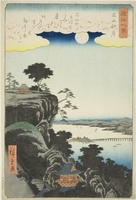 A large moon peaks out from beneath some clouds, high in the sky over Ishiyama temple. To the right, a river can be seen disappearing behind the cliffs that take up the foreground to the left.
A large moon peaks out from beneath some clouds, high in the sky over Ishiyama temple. To the right, a river can be seen disappearing behind the cliffs that take up the foreground to the left. -
 A blue and white crane takes up the entire foreground of the print. It sits upon a large branch of a pine tree, covered in fresh white snow. The crane preens its wings while it rests.
A blue and white crane takes up the entire foreground of the print. It sits upon a large branch of a pine tree, covered in fresh white snow. The crane preens its wings while it rests. -
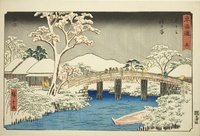 People walk across a bridge above the Katabira River during a snowy winter day. Hiroshige uses the negative space on the paper to create stark white contrasts with the rest of the print. The sky is painted gray to emphasize the gloominess of the weather.
People walk across a bridge above the Katabira River during a snowy winter day. Hiroshige uses the negative space on the paper to create stark white contrasts with the rest of the print. The sky is painted gray to emphasize the gloominess of the weather. -

-

-
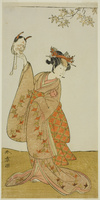 This painting was probably two parts of a triptych painting, and shows a dance sequence within a Kabuki play that would have been performed in Edo. In the play, a young warrior falls in love with a beautiful stranger who ends up being a demon. The painting depicts the young woman holding up a demon mask.
This painting was probably two parts of a triptych painting, and shows a dance sequence within a Kabuki play that would have been performed in Edo. In the play, a young warrior falls in love with a beautiful stranger who ends up being a demon. The painting depicts the young woman holding up a demon mask. -
 A samurai stands with his head lowered, a demon woman gripping his hair. She holds a stick above her with intention to beat the samurai.
A samurai stands with his head lowered, a demon woman gripping his hair. She holds a stick above her with intention to beat the samurai. -
 A woman sits on the floor, and a child dances around to the left of her. Above them, a tea kettle is flying away with wings. The woman holds a tool above her head, ready to strike the tea kettle.
A woman sits on the floor, and a child dances around to the left of her. Above them, a tea kettle is flying away with wings. The woman holds a tool above her head, ready to strike the tea kettle. -
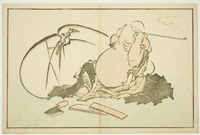 Hotei, the Buddhist god of fortune and good luck, sits on the ground smoking a pipe. He has a content look on this face. In front of him sits a wood carving tool and a piece of wood.
Hotei, the Buddhist god of fortune and good luck, sits on the ground smoking a pipe. He has a content look on this face. In front of him sits a wood carving tool and a piece of wood. -
 A tiger stands on land with its front paws on the head of a green dragon. It is sinking its teeth into the head of the dragon. The dragon is flying over a body of water, with what appears to be a black cloud of smoke around it.
A tiger stands on land with its front paws on the head of a green dragon. It is sinking its teeth into the head of the dragon. The dragon is flying over a body of water, with what appears to be a black cloud of smoke around it. -
 A warrior stands with a demon on his back. The man looks up at the demon, and in return, the demon looks down at him. The demon is grabbing on to the warriors robes.
A warrior stands with a demon on his back. The man looks up at the demon, and in return, the demon looks down at him. The demon is grabbing on to the warriors robes. -
 A warrior stands on temple steps with a sword in one hand and a sign in the other. A large, green demon is grabbing onto the warrior's helmet, trying to drag him up the stairs.
A warrior stands on temple steps with a sword in one hand and a sign in the other. A large, green demon is grabbing onto the warrior's helmet, trying to drag him up the stairs. -
 Two men are engaged in battle with each other. The man on the left is painted red, suggesting that perhaps he is a demon or some other kind of mythological creature.
Two men are engaged in battle with each other. The man on the left is painted red, suggesting that perhaps he is a demon or some other kind of mythological creature. -
 Kintoki, a popular hero from Japanese folklore, is fighting a tengu, or a mythical birdman that supposedly lived on Mount Kurama. Kintoki was known for engaging in battle with supernatural creatures, and supposedly had legendary strength as a child.
Kintoki, a popular hero from Japanese folklore, is fighting a tengu, or a mythical birdman that supposedly lived on Mount Kurama. Kintoki was known for engaging in battle with supernatural creatures, and supposedly had legendary strength as a child. -
 The demon queller Shoki rides on a tiger through a group of "goblins," or demons. His tiger gnaws on one of the demons while Shoki slaughters them with his sword. This print was done a little after the end of the Edo period (1603-1867).
The demon queller Shoki rides on a tiger through a group of "goblins," or demons. His tiger gnaws on one of the demons while Shoki slaughters them with his sword. This print was done a little after the end of the Edo period (1603-1867). -
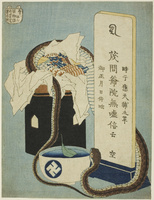 A snake is shown crawling over a display of items used in memorial service for the dead. In this case, the snake is representative of malevolence. The tablet on the right displays the Buddhist name of the dead.
A snake is shown crawling over a display of items used in memorial service for the dead. In this case, the snake is representative of malevolence. The tablet on the right displays the Buddhist name of the dead. -
 A demon slayer sits over a stone and fire, sharpening his sword.
A demon slayer sits over a stone and fire, sharpening his sword. -
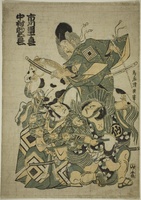 Three Kabuki actors are performing in the play "Miura no Osuke Bumon no Kotobuki." They are in the middle of drawing their swords. A horse can be seen in the background.
Three Kabuki actors are performing in the play "Miura no Osuke Bumon no Kotobuki." They are in the middle of drawing their swords. A horse can be seen in the background. -
 A young woman holding a pan pipe rides on the back of a Phoenix. In the bottom right corner, flowers bloom.
A young woman holding a pan pipe rides on the back of a Phoenix. In the bottom right corner, flowers bloom. -
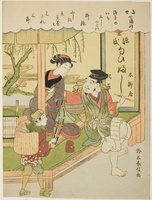 Ebisu, the god of fishing and commerce, and one of the seven gods of good luck, appears to a woman and a child. A list sits on his lap and he holds some kind of pipe or pen in his hand.
Ebisu, the god of fishing and commerce, and one of the seven gods of good luck, appears to a woman and a child. A list sits on his lap and he holds some kind of pipe or pen in his hand. -
 A yokai, or ghost, of a woman floating from a well. According to the ghost story, the woman was murdered by her husband after breaking plates and thrown into a well with the shards of broken plates. She returned every night to haunt her husband.
A yokai, or ghost, of a woman floating from a well. According to the ghost story, the woman was murdered by her husband after breaking plates and thrown into a well with the shards of broken plates. She returned every night to haunt her husband. -
 A woodblock print of Kabuki actor Ichikawa Ebizo II. He is presumably performing in a play wherein he casts a curse. The woodblock print is unique in that it is hand-painted.
A woodblock print of Kabuki actor Ichikawa Ebizo II. He is presumably performing in a play wherein he casts a curse. The woodblock print is unique in that it is hand-painted. -
 A ghost depicted as a skeleton haunts a cowering woman. This woodblock print is a depiction of a play, "Flower of Edo: An Ichikawa Saga”, in which the monk Seigen falls in love with Cherry Princess Sakura-hime. He dies, alone and poor, after being driven from his temple for their affair, and haunts her after his death.
A ghost depicted as a skeleton haunts a cowering woman. This woodblock print is a depiction of a play, "Flower of Edo: An Ichikawa Saga”, in which the monk Seigen falls in love with Cherry Princess Sakura-hime. He dies, alone and poor, after being driven from his temple for their affair, and haunts her after his death. -
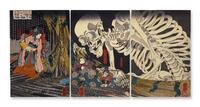 Princess Takiyasha summons a specter in order to scare her father's killer, Oya Taro Mitsukuni. He is fending off Princess Takiyasha's henchman while also trying to escape the skeleton.
Princess Takiyasha summons a specter in order to scare her father's killer, Oya Taro Mitsukuni. He is fending off Princess Takiyasha's henchman while also trying to escape the skeleton.